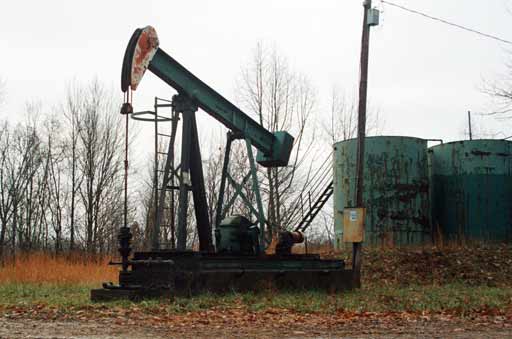|
 |
The photograph above shows a currently producing oil well with its “pumpjack” and tank for temporary storage of oil until a truck comes to get it. These pumps generally run intermittantly as the oil seeps into the hole at the bottom. This pump jack runs on electricity. Other may run on gasoline motors and should have mufflers. |
Oil wells do not function on this natural pressure.
The “pumpjacks” shown here that you see in the countryside are for oil wells, not gas wells. Oil has to be pumped out of oil wells. (Only rarely in West Virginia’s stratigraphic traps is there the gusher shown in the movies.) The oil is then stored in tanks near the well, or near a group of oil wells. Later trucks come to the oil wells and haul the oil to market.
(“Secondary Recovery” is a process in which gas or fluids are pumped down one set of, usually, oil wells, out the bottom of those oil wells and through the oil-bearing strata in order to push oil horizontally through the strata, to be pumped up and out of a set of neighboring oil wells. This introduction of pressure into underground strata is VERY risky for groundwater and surface owners.)
Although the principles of well spacing and royalty sharing are the same for oil wells, the illustrations in this slide show and most of the narrative focuses on gas wells. Gas well drilling is far more common than oil well drilling in West Virginia.
| Go directly to intro or slide: 1 2 3 4 5 6 7 8 9 10 11 12 13 14 15 16 17 18 19 20 21 22 23 24 24a 25 26 27 28 29 30 31 32 33 |